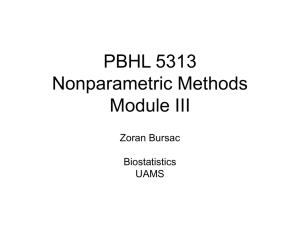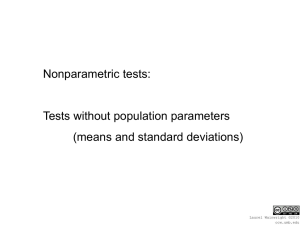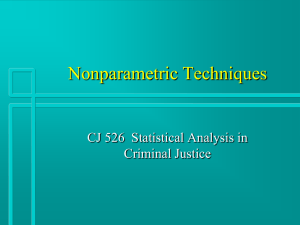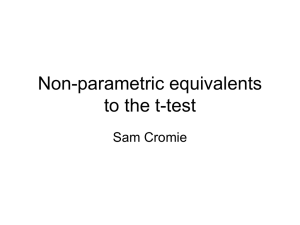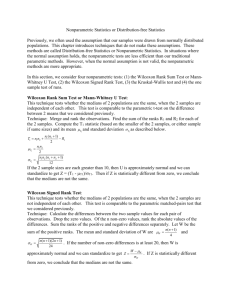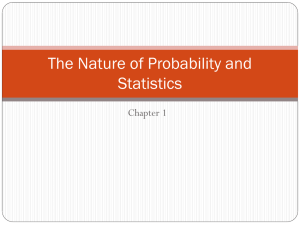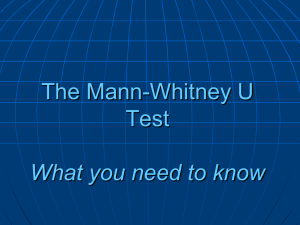Chapter 20
advertisement
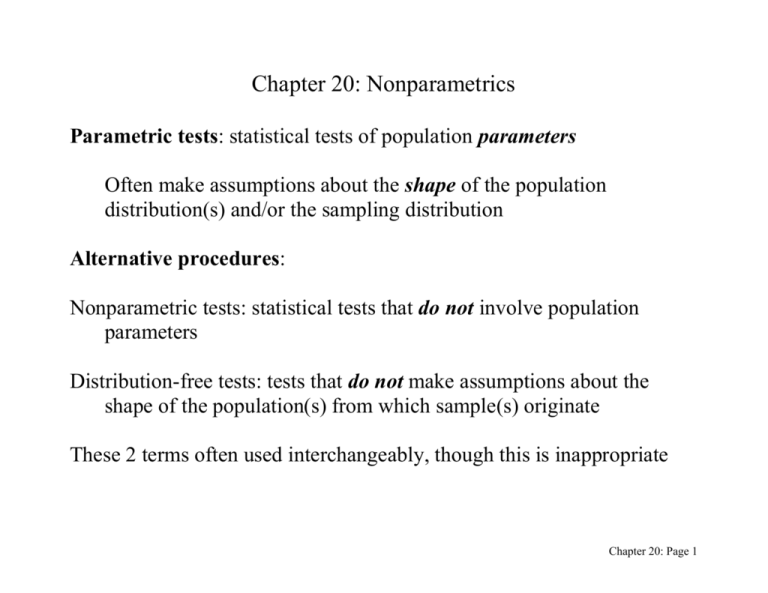
Chapter 20: Nonparametrics Parametric tests: statistical tests of population parameters Often make assumptions about the shape of the population distribution(s) and/or the sampling distribution Alternative procedures: Nonparametric tests: statistical tests that do not involve population parameters Distribution-free tests: tests that do not make assumptions about the shape of the population(s) from which sample(s) originate These 2 terms often used interchangeably, though this is inappropriate Chapter 20: Page 1 Why use Nonparametric/Distribution-free tests? 1. Useful when statistical assumptions have been violated 2. Ideal for nominal (categorical) and ordinal (ranked) data 3. Useful when sample sizes are small (as this is often when assumptions are violated) 4. Many resistant to outliers, b/c many rely on ranked, rather than raw scores Why NOT use Nonparametric/Distribution-free tests? 1. Tend to be less powerful than their parametric counterparts 2. H0 & H1 not as precisely defined There is a nonparametric/distribution-free counterpart to many parametric tests. We will discuss 3 common ones. Chapter 20: Page 2 The Mann-Whitney U Test: The nonparametric counterpart of the independent samples t-test Independent samples t: Do the means of 2 groups differ significantly? Mann-Whitney U: Do the distributions of 2 groups differ significantly? H0: The two samples come from identical populations H1: The two samples do not come from identical populations If the population distributions are similar in shape, the hypotheses are testing if the central tendency (“center”) of the distributions are equal or not Consider the following two sets of distributions Chapter 20: Page 3 Figure A In Figure A, the 2 distributions overlap quite a bit Suppose we combined the 2 distributions into one larger distribution, & then ranked each score from lowest to highest Suppose we then summed the ranks for each distribution separately When there is a great deal of overlap, the sum of the ranks are close to equal Chapter 20: Page 4 Figure B In Figure B, the 2 distributions overlap very little Suppose we combined the 2 distributions into one larger distribution, & then ranked each score from lowest to highest Suppose we then summed the ranks for each distribution separately When there is little overlap, the sum of the ranks differ quite a bit Thus, when samples come from the same distribution (H0 is true), the ranks from each group will be equal or nearly equal When the samples come from different distributions (H0 is not true), the ranks will differ quite a bit Chapter 20: Page 5 Example: You have a group of 6 first-graders & of 6 second-graders. You want to determine if the self-esteem of these groups differs. You are unsure if self-esteem is normally distributed in the population, and b/c of the small n, the assumption that the sampling distribution of the mean is normal is questionable Here are the data: 1st Graders 14, 36, 50, 82, 68, 76 2nd Graders 10, 57, 90, 85, 73, 55 Let’s rank all the scores, ignoring the group origin of the scores: 10, 14, 36, 50, 55, 57, 68, 73, 76, 82, 85, 90 1, 2, 3, 4, 5, 6, 7, 8, 9, 10, 11, 12 ranks (1st graders): 2 + 3 + 4 + 7 + 9 + 10 = 35 ranks (2nd graders): 1 + 5 + 6 + 8 + 11 + 12 = 43 Mathematically, the Mann-Whitney U test determines if the ranks are significantly different between the groups Chapter 20: Page 6 SPSS output: Mann-Whitney Test Ranks self es teem grade firs t grade second Total N 6 6 12 Mean Rank 5.83 7.17 Test Statisticsb Tied scores can be dealt w/ in several ways Mann-Whitney U Wilcoxon W Z As ymp. Sig. (2-tailed) Exact Sig. [2*(1-tailed Sig.)] self es teem 14.000 35.000 -.641 .522 Sum of Ranks 35.00 43.00 Report the z & this pvalue a .589 a. Not corrected for ties . b. Grouping Variable: grade Chapter 20: Page 7 Interpretation: If you can reasonably assume that the distributions of your groups have roughly the same shape, then rejection of H0 means that the central tendency of the 2 groups (typically the medians) are different. Failing to reject H0 means that we have insufficient evidence to conclude that the central tendency of the 2 groups (typically the medians) are different. In the above example: “A Mann-Whitney U test showed that first graders and second graders do not appear to differ in their levels of self-esteem, z = -.641, p > .05, two-tailed.” Chapter 20: Page 8 As another example, suppose our data for the self-esteem study had looked like this instead: 1st Graders 14, 10, 19, 68, 45, 33 2nd Graders 22, 57, 90, 85, 73, 55 Let’s rank all the scores, ignoring the group origin of the scores: 10, 14, 19, 22, 33, 45, 55, 57, 68, 73, 85, 90 1, 2, 3, 4, 5, 6, 7, 8, 9, 10, 11, 12 ranks (1st graders): 1 + 2 + 3 + 5 + 6 + 9 = 26 ranks (2nd graders): 4 + 7 + 8 + 10 + 11 + 12 = 52 Chapter 20: Page 9 SPSS Output: Mann-Whitney Test Ranks self es teem grade firs t grade second Total N 6 6 12 Mean Rank 4.33 8.67 Sum of Ranks 26.00 52.00 Test Statisticsb Mann-Whitney U Wilcoxon W Z As ymp. Sig. (2-tailed) Exact Sig. [2*(1-tailed Sig.)] self es teem 5.000 26.000 -2.082 .037 a .041 a. Not corrected for ties . b. Grouping Variable: grade The interpretation this time would be: “A Mann-Whitney U test showed that second graders have higher levels of self-esteem than first graders, z = -2.082, p .05, two-tailed.” Chapter 20: Page 10 The Wilcoxon Signed Rank Test: The nonparametric counterpart of the related samples t-test Related samples t: Measure one group of Ps twice on the same variable. Is the average difference score different from zero? H0: The two related samples come from populations with the same distribution H1: The two related samples do not come from populations with the same distribution If the distributions are both symmetric, the hypotheses are testing if the distribution of difference scores is symmetric around zero Chapter 20: Page 11 Example: You have 10 patients. You measure their cholesterol before and after a one-year exercise program. You want to determine if the cholesterol levels were altered by the exercise. You are unsure if cholesterol is normally distributed in the population, and b/c of the small n, the assumption that the sampling distribution of the mean is normal is questionable Participant Before After Difference 1 2 3 4 5 6 7 8 9 10 180 200 175 210 240 190 180 195 203 225 175 184 181 190 200 180 182 191 190 205 5 16 -6 20 40 10 -2 4 13 15 If the exercise program has a systematic effect on the Ps, then the sign of the difference scores will all tend to be the same For instance, if we take before – after scores, & if exercise reduces cholesterol, then the vast majority of the difference scores should have a + sign Chapter 20: Page 12 Also any increases in cholesterol (resulting in negative difference scores), should have small magnitudes If exercise has no impact on cholesterol, then roughly half of the difference scores should have a + & half should have a – sign, & the magnitudes of both would be roughly equal Participant Before After Difference Ranked |Difference| Signed Rank 1 2 3 4 5 6 7 8 9 10 180 200 175 210 240 190 180 195 203 225 175 184 181 190 200 180 182 191 190 205 5 3 3 16 -6 20 40 10 -2 4 8 4 9 10 5 1 2 8 -4 9 10 5 -1 2 13 15 6 7 6 7 (positive ranks): 3 + 8 + 9 + 10 + 5 + 2 + 6 + 7 = 50 (negative ranks): -4 – 1 = -5 Conceptually, the Wilcoxon Signed Rank test determines if the magnitude of the sum of the pos or neg ranks is improbable, if H0 is true Chapter 20: Page 13 Put another way: We had 8 positive difference scores (out of 10) in our problem, & of those 8 positive ranks was 50. Is this improbable? Is this unusually large, if H0 is true? SPSS output: Wilcoxon Signed Ranks Test Ra nks N Tied difference scores are often dropped Before - After Negative Ranks Positive Ranks Ties Total 2a 8b 0c 10 Mean Rank 2.50 6.25 a. Before < After b. Before > After c. Aft er = Before Sum of Ranks 5.00 50.00 Report the z & this pvalue Test Statisticsb Z As ymp. Sig. (2-tailed) Before - After -2.295a .022 a. Based on negative ranks . b. Wilcoxon Signed Ranks Test Chapter 20: Page 14 Interpretation: “A Wilcoxon Signed Rank test showed that the exercise program does appear to reduce cholesterol levels, z = -2.295, p .05, two-tailed.” The Kruskal-Wallis Test: The nonparametric counterpart of one-way ANOVA One-way ANOVA: Measure 3+ groups of Ps on the same variable. Is there a difference somewhere among the 3 means? H0: All samples come from identical populations H1: All samples do not come from identical populations If the distributions are similar in shape, the hypotheses are testing if the central tendency (“center”) of the distributions are equal or not Chapter 20: Page 15 The logic of this test is quite similar to the Mann-Whitney U test. --You rank all the scores, ignoring their group membership --Then you sum the ranks for each group separately --When samples come from the same distribution (H0 is true), the ranks from each group will be equal or nearly equal --When the samples come from different distributions (H0 is not true), the ranks will differ quite a bit Example: You are interested to know if housing costs differ by region. You sampled 4 people who live in 3 different regions of the US and recorded how much they paid for their home. Below are the data West Coast $800,000 1,000,000 $525,000 $750,000 East Coast $585,000 $320,000 $280,000 $600,000 Midwest $175,000 $240,000 $145,000 $210,000 Chapter 20: Page 16 The distribution of housing costs is known to be skewed Let’s rank all the scores, ignoring the group origin of the scores: 145k, 175k, 210k, 240k, 280k, 320k, 525k, 585k, 600k, 750k, 800k, 1 mil 1, 2, 3, 4, 5, 6, 7, 8, 9, 10, 11, 12 ranks (Midwest): 1 + 2 + 3 + 4 = 10 ranks (East Coast): 5 + 6 + 8 + 9 = 28 ranks (West Coast): 7 + 10 + 11 + 12 = 40 Mathematically, the Kruskal-Wallis Test will determine if the ranks are significantly different across the groups Chapter 20: Page 17 SPSS output: Kruskal-Wallis Test Ranks COST REGION Midwes t East Coast West Coas t Total N 4 4 4 12 Mean Rank 2.50 7.00 10.00 Test Statisticsa,b Chi-Square df As ymp. Sig. COST 8.769 2 .012 Report the 2, the df, & p-value a. Kruskal Wallis Test b. Grouping Variable: REGION Interpretation: “A Kruskal-Wallis Test showed that region affects housing costs, 2 (2, N = 12) = 8.769, p .05.” Chapter 20: Page 18 As with standard one-way ANOVA, you can follow up a significant finding with multiple-comparison procedures In the case of a Kruskal-Wallis test, you would conduct all possible Mann-Whitney U tests between pairs of ranks. Chapter 20: Page 19
